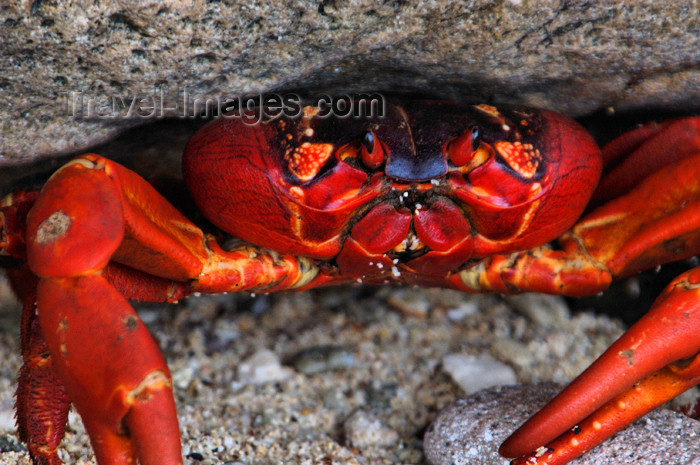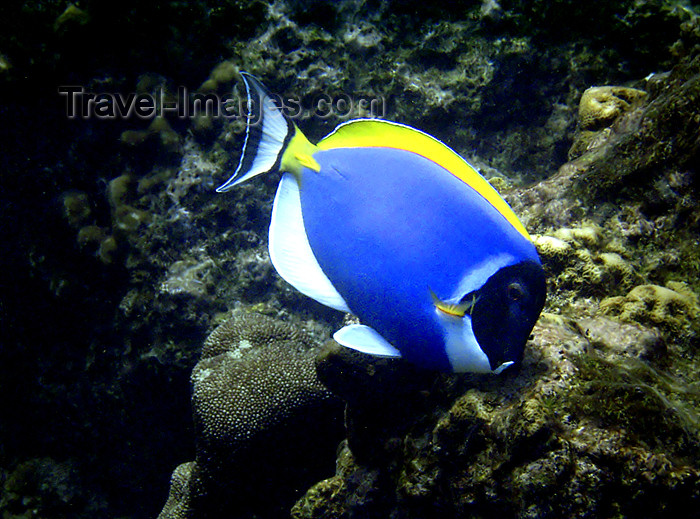| Travel
Articles for Publishers |
Travel-Images.com
|
|
|
The travel article below
is available for publishing, with or without photos (more
images available). Please contact us
with details about your publication for a detailed quote. Both this article
and all the images are copyrighted. Other travel
articles are also available for publishing.
Christmas island - Crabs
for Christmas
the Red Crab Migration
by Bill Cain
 I
remember watching a Discovery Channel program several years ago that counted
down the top 10 migrations around the world. As the countdown progressed,
some of the more familiar animal species like the wildebeests of Africa
and the swallows of Capistrano were highlighted. When the program reached
the number one, and thus the greatest, migration of them all, imagine my
surprise and probably that of most other viewers when that distinction
was revealed to be the red crabs of Christmas Island – an exotic,
far flung dot on the chart of the Indian Ocean! Right away I knew I had
to witness this for myself.
I
remember watching a Discovery Channel program several years ago that counted
down the top 10 migrations around the world. As the countdown progressed,
some of the more familiar animal species like the wildebeests of Africa
and the swallows of Capistrano were highlighted. When the program reached
the number one, and thus the greatest, migration of them all, imagine my
surprise and probably that of most other viewers when that distinction
was revealed to be the red crabs of Christmas Island – an exotic,
far flung dot on the chart of the Indian Ocean! Right away I knew I had
to witness this for myself.
Discovered by a British ship on December
25, 1643, the island changed hands several times before finally ending
up under the Australian flag in 1958. About the size of Martha’s Vineyard,
it lies 1,615 miles from the Australian mainland city of Perth, but just
a scant 223 miles from the Indonesian island of Java, and because only
twice-weekly flights connect from both Perth and Bali, Indonesia, careful
planning for a visit is necessary. Unlike its nearest island neighbors,
the Cocos, which are a series of flat atolls, Christmas has a rugged mountainous
and forested interior which give refuge to 14 different species of land
crabs, among which is the famous red crab found nowhere else in the world
and whose numbers on this relatively tiny island are staggering.
Despite its reputation as a remote tropical
haven for exotic, crawling creatures, the island has a human population
of about 1,200 evenly mixed Australians, Chinese and Malays all clustered
in a solitary town called simply the Settlement, which has served as the
base for the island’s lone industry of phosphate mining and export. Bird
life is remarkably plentiful, the scuba diving is world class and there’s
also a nine hole golf course.
Though Christmas Island and its fledgling
tourist bureau offer other reasons for visiting, the primary one from the
end of October through the beginning of December each year is to witness
an estimated 50 – 100 million red crabs which perform an incredible march
from their inland burrows to the shore and back in order to satisfy their
mating and reproduction ritual that was genetically programmed long before
humans ever arrived.
Like most other naturally recurring events,
the beginning of the migration and the different phases of the red crab’s
movements and activities varies from year to year and is dictated by rain
events as well as the phases of the moon and its effect upon ocean tides
– an important factor when newly fertilized eggs are released into the
ocean. The first and most spectacular stage of the migration is when all
the crabs, prompted by biological programming, proceed to march to the
sea en mass whereupon, after mating, the males replenish nutrients
from the sea water and the females release their sacks of eggs. This part
of the migration, however, lasts only 5-7 days between the end of October
and the end of November. Consequently, it’s almost impossible to plan a
trip to coincide with this small window of opportunity, especially from
halfway around the world. As luck would have it, my recent visit was too
late, as the main march in 2005 was unusually early.
 For
those fortunate enough to time it right, the extra diligence is especially
rewarding as the spectacle is nothing short of astonishing. Like something
out of a horror movie, millions upon millions of crabs, resembling an advancing
red carpet in some places, literally run over, under and through everything
that stands in their way to the coastline. Moving during the cooler mornings
and late afternoons, they invade homes, back yards, commercial properties,
parks, and the golf course. Residents take heed to keep their doors closed
during this time, as it’s not unusual to open a closet only to find a stray
crab staring you down. Sadly, however, the crabs must also pass over many
roadways in their blind obedience to procreation.
For
those fortunate enough to time it right, the extra diligence is especially
rewarding as the spectacle is nothing short of astonishing. Like something
out of a horror movie, millions upon millions of crabs, resembling an advancing
red carpet in some places, literally run over, under and through everything
that stands in their way to the coastline. Moving during the cooler mornings
and late afternoons, they invade homes, back yards, commercial properties,
parks, and the golf course. Residents take heed to keep their doors closed
during this time, as it’s not unusual to open a closet only to find a stray
crab staring you down. Sadly, however, the crabs must also pass over many
roadways in their blind obedience to procreation.
Christmas Island redefines the term “road
kill” and takes it to another level. Although the island’s park service
has erected barriers, stalled grids along many of the roads and even closes
some roads in an effort to minimize the yearly carnage, it’s simply not
enough. All these attempts since 1980 when concerted efforts were
begun to protect as many crabs as possible seem pitifully inadequate when
the
numbers are tabulated. Estimates suggest that about 1% of the island’s
crab population, or between 500,000 and one million crabs, annually end
up as motor vehicle fatalities.
Thousands of black smudge marks, indicating
where hits had taken place a couple of weeks before my arrival, could be
seen on many of the roads – some marks being no more than a few feet apart
and continuing in two parallel tire track lines for up to ¼ mile
in some places. Even though I missed the height of this gruesome aspect
of the great migration, enough stragglers were still marching on some of
the roadways during my visit. Dodging and weaving as best I could at slow
speed to avert further harm, there nevertheless were some areas where the
sickening crunching sound of car tire meeting crab shell was unavoidable.
It wouldn’t have been so disconcerting were it not for the fact that red
crabs are big, ranging in comparable size from that of a chipmunk to that
of a grey squirrel for some of the larger specimens.
After reaching their coastal destinations,
the male crabs take their “dip”, while the females collectively release
billions of their fertilized eggs into the ocean where they are washed
out to sea, only a small portion of which return once every five
to six years as immature crablings and the next generation of marching
red crabs. Most other years the young perish as food for a variety of the
island’s fish population.
For the next month or so, after completing
their coastal encounter, the crabs begin their sporadic and much less impressive
return migration to their homes in the interior.
Fortunately for the crabs, they are unsuitable
for human consumption. Otherwise, the commercial exploitation would certainly
have begun long ago and their numbers might be far fewer and less impressive
than they currently are. This is not the case, though, for some of the
island’s other land crab species, most notably the blue crab and the enormous
and colorful robber crab – both of which reportedly are delectable but,
because of their far fewer numbers, have been protected and designated
as endangered by the Christmas Island authorities.
| Travel Articles |
www.travel-images.com
|
 I
remember watching a Discovery Channel program several years ago that counted
down the top 10 migrations around the world. As the countdown progressed,
some of the more familiar animal species like the wildebeests of Africa
and the swallows of Capistrano were highlighted. When the program reached
the number one, and thus the greatest, migration of them all, imagine my
surprise and probably that of most other viewers when that distinction
was revealed to be the red crabs of Christmas Island – an exotic,
far flung dot on the chart of the Indian Ocean! Right away I knew I had
to witness this for myself.
I
remember watching a Discovery Channel program several years ago that counted
down the top 10 migrations around the world. As the countdown progressed,
some of the more familiar animal species like the wildebeests of Africa
and the swallows of Capistrano were highlighted. When the program reached
the number one, and thus the greatest, migration of them all, imagine my
surprise and probably that of most other viewers when that distinction
was revealed to be the red crabs of Christmas Island – an exotic,
far flung dot on the chart of the Indian Ocean! Right away I knew I had
to witness this for myself.
